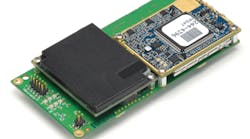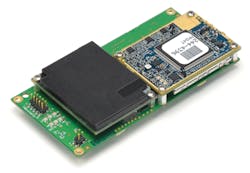This file type includes high resolution graphics and schematics when applicable.
With government and defense applications seemingly never having enough radio communications bandwidth, radio supplier FreeWave Technologies has added several 2.4-GHz board-level radios to its Spartan Series of products. The latest Spartan radio is well suited for command-and-control (C2) links in unmanned aerial vehicles (UAVs) and unmanned ground vehicles (UGVs) where minimizing size, weight, and power are chief concerns. The unit includes Federal-Information-Processing-Standard (FIPS) 140-2 Level-2 encryption, along with 32-b cyclic-redundancy-check (CRC) error detection with automatic retransmission [enabling reliable data communications at line-of-sight (LOS) distances to 60 miles].
The new user-programmable Spartan radio card (see figure) is available with a serial interface; it operates with output-power levels of 20 to 500 mW by means of seven user-selectable frequency-hopping bands working across a total bandwidth of 2.400 to 2.843 GHz. The occupied bandwidth is only 230 kHz. The radios feature two-level Gaussian-frequency-shift-keying (GFSK) modulation. The selectivity is typically 20 dB within 230 kHz of the operating center frequency. The radios offer user-selectable data rates of 115 or 153 kb/s with nominal sensitivity of -103 dBm at a data rate of 153 kb/s and 1 x 10-6 bit-error rate (BER) and -106 dBm at a data rate of 115 kb/s and 1 x 10-6 BER.
The different models are the M24-NCF radio with serial interface, measuring 106.7 x 50.8 x 14.1 mm, and the M24-NCF-CC, which is a conformal-coated version of the M24-NCF. The radios—which are supplied with MMCX connectors, and weigh 66.9 g or less—are available with RS-232 protocols, supporting data interfaces operating at rates of 1.2 to 115.2 kb/s. They work on supply voltages from +4.75 to +5.25 VDC and typically draw 1200 mA current at +5 VDC in transmit mode, 240 mA at +5 VDC in receive mode, and 135 mA at +5 VDC in idle mode.
The firm claims more than 75,000 radios in the field for government and defense data-transmission applications. With their FIPS 140-2 Level 2 crypto algorithm, these radios support counter mode, which uses a sequence of blocks to encrypt data that is never repeated. This makes critical data more secure than data sent using the standard authenticated encryption scheme (AES) codebook, where a given block of data will always return the same encrypted block of data.
FreeWave Technologies, Inc., 5395 Pearl Pkwy., Ste., 100, Boulder, CO 80301; (866) 923-6168, (303) 381-9200, FAX: (303) 786-9948.
This file type includes high resolution graphics and schematics when applicable.


